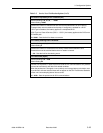
3. Configuration Options
3-18 December 2002 9000-A2-GB31-00
T1 Network Interface
FrameSaver Models 9123, 9126, and 9128 have a T1 network interface.
Table 3-7. T1 Network Physical Interface Options (1 of 4)
Line Framing Format
Possible Settings: D4, ESF
Default Setting: ESF
Specifies the framing format for transmitted and received signals on the T1 network
interface.
D4 – Uses D4 framing format.
NOTE: This setting is not recommended by network carriers. False yellow alarms may
occur after traffic has been running and the channel returns to idle, or when there is
light traffic when other settings are selected. ESF format does not create this problem.
ESF – Uses Extended Superframe framing format.
Line Coding Format
Possible Settings: AMI, B8ZS
Default Setting: B8ZS
Specifies the line coding format for the network interface.
AMI – Uses Alternate Mark Inversion (AMI) line coding format.
B8ZS – Uses Bipolar 8 Zero Substitution (B8ZS) line coding format.
Line Build Out
Possible Settings: 0.0, –7.5, –15, –22.5
Default Setting: 0.0
Specifies the line build out for the signal transmitted to the network.
0.0, –7.5, –15, –22.5 – Specifies line build out in dB.
Bit Stuffing
Possible Settings: 62411, Disable
Default Setting: 62411
Determines the type of bit insertion to provide ones density requirements for data
transmitted to the network.
Display Conditions – This option does not appear when Line Coding Format is set to
B8ZS.
62411 – Inserts a one in the data after 15 consecutive zeros are received or the density of
ones falls below 12.5%. This setting complies with AT&T TR 62411, but is not
recommended for frame relay data because it inserts errors in the data traffic.
Disable – Disables bit stuffing. Ones density is not enforced on data sent to the network.


















